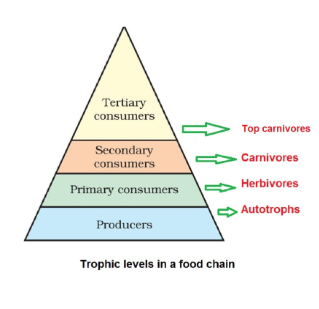Table of Contents
What is a Trophic Level?
In an ecosystem, the trophic level indicates an organism’s position in the food chain and its role in energy transfer. For instance, let’s consider a trophic level example in a forest.
Plants, like trees and shrubs, belong to the first trophic level, primary producers, as they generate their food through photosynthesis. Herbivores, such as deer, exist at the second trophic level as primary consumers, feeding on these plants. If a carnivore like a wolf preys on the deer, it occupies the third trophic level as a secondary consumer. If a top predator like a mountain lion hunts the wolf, it reaches the fourth trophic level.
This hierarchy in trophic levels within a trophic level biology structure showcases energy flow through an ecosystem.
Food Chain Trophic Levels
A trophic level is a crucial concept in ecosystems that helps us understand the relationships between animals and plants. It represents the position of organisms in a food chain or food web, indicating who eats whom and how energy flows. In biology, trophic levels serve as steps that showcase the transfer of energy and nutrients from one level to another.
For instance, consider a trophic level example where plants (primary producers) are eaten by herbivores (primary consumers), which are then consumed by carnivores (secondary consumers). This illustrates the movement of energy through different levels.
The food chain trophic levels notes include various stages: primary producers, primary consumers, secondary consumers, and even tertiary consumers. These stages are like chapters in an ecosystem’s energy transfer story.
In an ecosystem, the arrangement of trophic levels shapes the food chain trophic levels diagram, showing who eats whom. The interconnectedness of various food chains forms a complex network called a food web.
In summary, trophic levels are essential in understanding how energy and nutrients flow through an ecosystem, creating a dynamic web of interactions among animals, plants, and the environment.
Trophic Level Diagram
A trophic level diagram is a visual representation that illustrates the hierarchy of different organisms in an ecosystem based on their position in a food chain or food web. It depicts the flow of energy and nutrients from one level to another, showing how organisms are connected through their feeding relationships.
In the diagram, primary producers like plants are usually at the bottom, followed by primary consumers (herbivores), secondary consumers (carnivores), and sometimes tertiary consumers (top predators) at the highest levels.
The trophic level diagram helps us grasp the complex interactions and dependencies within an ecosystem’s food chains and webs. Understanding the trophic level diagram is crucial for comprehending the dynamics of energy transfer and nutrient cycling in ecosystems.

Types of Trophic Levels
Trophic levels are organisms’ different positions in a food chain or food web within an ecosystem. They indicate the flow of energy and nutrients as one organism consumes another. There are several types of trophic levels, each with its unique role in the ecosystem:
- Primary Producers: These are the organisms at the lowest trophic level, often plants and some types of algae. They use sunlight to produce energy through photosynthesis, forming the base of the food chain.
- Primary Consumers: Also known as herbivores, these organisms feed directly on primary producers. They are the second trophic level and include animals like grazing animals that eat plants.
- Secondary Consumers: These organisms occupy the third trophic level and feed on primary consumers. They can be carnivores that eat herbivores or omnivores that consume plants and animals.
- Tertiary Consumers: Found at the fourth trophic level, these are carnivores that prey on other carnivores or omnivores. They help regulate the population of lower trophic levels.
- Quaternary Consumers: In some ecosystems, there might be a fifth trophic level consisting of top predators, often referred to as quaternary consumers. These apex predators have few or no natural predators.
- Decomposers: Decomposers play a vital role while not considered an independent trophic level. They break down dead organic matter, recycling nutrients into the ecosystem and maintaining health.
Understanding these different trophic levels is essential for comprehending ecosystems’ intricate relationships and energy flow.
Frequently Asked Questions on Tropic Levels
Define trophic level.
A trophic level refers to an organism's position in a food chain or web, indicating its role in transferring energy and nutrients.
What is the trophic level in food chain?
In a food chain, a trophic level signifies where an organism stands as a consumer or producer, shaping its role in the energy flow.
What is a trophic level in biology?
In biology, a trophic level pertains to the hierarchical arrangement of organisms within a food chain or web, reflecting their feeding relationships.
Trophic levels are formed by?
Trophic levels are formed by the transfer of energy as organisms eat and are eaten by others, creating a chain of feeding relationships.
What trophic level is Class 10?
Class 10 organisms are usually considered primary consumers, occupying the second trophic level by feeding on primary producers.






